#icons borja
Explore tagged Tumblr posts
Video
vimeo
Cartier x Six N. Five - Magicien from Six N. Five on Vimeo.
I am delighted to welcome you to this realm, where we have had the privilege of creating a short film that invites you into a magical world of new realities: the Cartier Magicien universe.
Since the begining of this journey I have been dedicated to pushing the boundaries of visual storytelling, and the Cartier Magicien project represents the culmination of many creations made over the past few years. Through a combination of different techniques and my own universes, a new piece has been born that invites viewers on an enchanting journey through the captivating and unique vision of Cartier watchmaking.
From the surreal to the sublime, each frame of the film is a testament to the power of digital art to evoke sensations, ignite the imagination, and transport audiences into new realms. With a focus on beauty and a talented team committed to creating something unique and distinct, we have crafted a piece that showcases Cartier’s iconic collections and celebrates the art and ingenuity of digital storytelling.
Cartier x Six N. Five Commisioned by Publicis Luxe and Prodigious France
Shortfilm created by Ezequiel Pini a.k.a Six N. Five
Creative Direction: Ezequiel Pini Director & Film Direction: Sebastián Baptista Executive Production: Belén Palos Production Coordination: Max Palou Studio Coordination: Lina Cabrera
Production team Art Direction: Ezequiel Pini and Jesús Mascaraque 3D Lead: Maxime Roz 3D Art: Andy Lipe, Diego Diapolo, Thiago Tallman, Thais Altes, Borja Alegre, Joan Garcia Pons, Maximilien Vert, Macs Riedel Animation: Macs Riedel, Riccardo Bottoni Simulations: Nil Estany, Matías Furno Watches Modeling &; Styling Artists: Iván Antón, Jordi Cerdà, Kornel Makarovic, Marco Segovia Audio Design: Aimar Molero Animatic: Macs Riedel, Eze Matteo Audio Design: Aimar Molero RnD process: Christoph Strohfeld, Simon Reher, Michele Resenterra Compositing: Alain Laza Barbieri
0 notes
Text
sixto & rosa
Tonight I was invited to a special event honouring Sixto Tovar and Rosa Borja who, some 35 years ago, embarked on a culinary adventure and created Eslava, a pioneer of modern takes on traditional tapas (EVERY gastrobar here owes them homage) that became one of Sevilla’s most iconic tapas bars. Earlier this year Sixto and Rosa made the difficult decision to retire (from the restaurant, they remain…

View On WordPress
0 notes
Text









🇪🇪 seja bem-vindo, miguel angel borja!
17 notes
·
View notes
Photo









like x
#icons#icons sociedade esportiva palmeiras#sociedade esportiva palmeiras#sociedade esportiva palmeiras icons#icons palmeiras#palmeiras#palmeiras icons#icons sep#sep#sep icons#icons lucas lima#lucas lima#lucas lima icons#icons fernando prass#fernando prass#fernando prass icons#icons borja#borja#borja icons#icons gustavo gómez#gustavo gómez#gustavo gómez icons#icons arthur cabral#arthur cabral#arthur cabral icons#icons jailson#jailson#jailson icons#icons bruno henrique#bruno henrique
15 notes
·
View notes
Text









#like/reblog if you save#like/reblog if using#icons#mugler 21#mugler#mugler 2021#runway#fashion#models#model icons#bella hadid#bella hadid icons#bella icons#dominique jackson#dominique jackson icons#patia#patia borja#patiasfantasyworld#hunter schafer#hunter schafer icons#alek wek icons#alek wek#ajok madel#ajok madel icons#ss 21#ss21#mugler ss 21#mugler ss
276 notes
·
View notes
Text


#borja garces#francisco javier montero#javi montero#atletico madrid b#segunda b#miniderby#borja pointing at the shirt (not the bedge) at a rm stadium#iconic#:’)#<333333
3 notes
·
View notes
Photo






miguel borja + real madrid packs
like ou créditos no @futebolpacks no twitter
#icons#miguel borja icons#miguel borja#borja icons#borja#headers#real madrid headers#real madrid#real madrid cf headers#real madrid cf#edit
4 notes
·
View notes
Photo









© @marcoasrensio
#real madrid#icons#real madrid icons#achraf hakimi icons#keylor navas icons#casemiro icons#lucas vazquez icons#marco asensio icons#marcelo icons#luca zidane icons#sergio ramos icons#borja mayoral icons#anna
44 notes
·
View notes
Photo









icons palmeiras
like ou c futebolou
#palmeiras#sep#icon#icons#se palmeiras#palmeiras icons#dudu#hyoran#gustavo scarpa#jailson#willian bigode#borja
8 notes
·
View notes
Photo

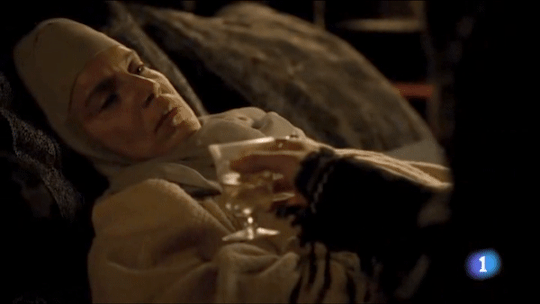
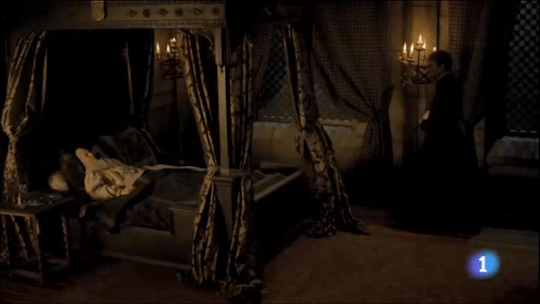
The Death of Queen Juana I
12 April 1555
Juana’s last weeks were spent in agonising pain. She habitually took baths with the help of her lavanderas de corp, Catalina and Marina Redonda. But in mid-February, scalding water blistered her skin. Sores developed on her back and buttocks. Lotions were applied but the agony that came with every movement made it difficult to move her and keep her clean. When, after several days, she was forcibly washed and her bedclothes changed, a spot of gangrene was noted on her left buttock. ‘Egyptian ointment’ was applied, but the gangrene spread. Her fesh was cauterised. Feverish, Juana refused to be bled or take medicine. She could not, or would not, move or be moved, and stopped eating.
Juana of Austria went to Tordesillas with several doctors: “I asked her Highness for permission to visit her,” the regent told Charles, “and, although she declined, nevertheless (seeing how much her illness had advanced) I went there and saw her. And because she seemed to feel such agitation (pesadumbre) at my being there, I returned, with her permission [to Valladolid], leaving the necessary surgeons and doctors …” Upset by the visit, the regent asked Borja if he would see the queen again, presumably to try to prepare her for a ‘good’ death. The viaticum (the sacrament of the Eucharist when administered to the dying to mitigate the punishments of purgatory) had to be received with genuine feeling. Honesty was essential. Contrition had to be real. The regent assured Charles that Borja had taken various “buenos religiosos” with him. Yet Borja himself did not, perhaps, feel that this was enough to ward off the demons that had troubled the queen. At the last minute, he turned to one of Salamanca’s greatest philosophers and most authoritative theologians, Domingo de Soto.
Unhappy at being asked to deal at a distance with the queen’s spiritual state, Soto hurried to Tordesillas on the morning of 11 April 1555. He saw Juana first with others, then returned to talk with her alone. Afterwards, he sent a report to royal secretary Vázquez de Molina, informing him that Juana had only hours to live and was unlikely to last the night. But he was satisfed that her judgment was clear—clearer than he had been led to expect. They had spoken together “at great length” and he had been “consoled” by their conversation. She had felt unable to accept (“no esta por”) the Eucharist, but unction might be administered, since this rite was not so demanding. They would, however, need to wait till she began to drift away, “because we fear that with the judgment she has now, because of her honesty (por su honestidad), she will not allow it.”
The viaticum was withheld, in part because the queen was vomiting, but also, perhaps, because of the “honestidad” that Soto mentions. That night, Borja administered extreme unction. Dr Santa Cara reports that Juana made a general confession and admission of having offended God, but this is mentioned neither by Soto nor Borja. According to a later description, possibly concerned to demonstrate the effect on the queen of Borja’s saintliness, she was still alert enough to recite, or partly recite, the creed. When asked if she wished it to be read out she told Borja: “You begin to say the creed and I’ll repeat it after you.” When words failed her, she repeatedly struck her chest. Her eyes fixed on that central icon of contemplation, the image of the suffering Christ, the queen kissed the crucifx he held out to her. Her last reported words, uttered a few hours before her death, were: “Jesu Christo crucificado sea conmigo” (“Jesus Christ crucifed, be with me”). Denia, also present, gave her words as “Jesu Christ crucifed, help me.” The queen died between six and half past six on the morning of Good Friday, 12 April, in the presence of Soto, Borja, Santa Cara and Denia. At last, the queen’s passion was over.
The absence abroad of many of Juana’s relatives might explain the low-key nature of Queen Juana’s burial at Santa Clara in Tordesillas. Still, the total lack of relatives at the interment of the embalmed body of the proprietary monarch, sovereign mistress and mother and grandmother of emperors and queens, is difficult to explain. Just a small handful of notables attended the rites. Various chaplains and cantors were sent from Valladolid for the ceremony, during which the body, formally recognised by the monteros de Espinosa, was lowered into the vault. The regent requested the holding of obsequies throughout Spain. A funeral ceremony was held at San Benito, Valladolid on 26 May. Grander obsequies were held by Ferdinand at Augsburg and in Brussels, where Charles attended a special ceremony on 25 May.
In London, the two-day obsequies for “Lady Jane,” whom Queen Mary may have wished to honour not only as aunt but as fellow queen regnant, assumed a special significance. They took place in “great solemnity” between 17 and 18 June, with Spanish and English nobles walking side by side behind a huge ornamental dome with a gilded canopy. The main event in Brussels was postponed, at King Philip’s request, until he could leave England. Eventually, at two o’clock in the afternoon of 16 September, a long procession made its way from the palace on the Coudenberg to the church of St Gudula. In their midst, a pony, covered with trappings of black velvet bordered with gold, led by Italian trainers and surrounded on four sides by the heralds of Castile, León, Aragon and Sicily, bore a woman’s saddle, embroidered with gold and bearing a cushion on which a magnificent crown sparkled with jewels. Philip was dressed, almost uniquely, in striking black mourning.
Source:
Gillian B. Fleming, Juana I
#Juana de Castilla#Juana of Castile#Joanna of Castile#Queen of Spain#Women in History#Spanish history#Laia Marull#Carlos Rey Emperador
70 notes
·
View notes
Text
Below you will find links to sorted screencaps from Doctor Who (2005) season 12 for the following one shot characters:
Alex Austin - Yedlarmi
Amy Booth-Steel - Hyph3n
Aruhan Galieva - Tahira
Aurora Marion - Noor Inayat Khan
Buom Tihngang - Tibo
Clare-Hope Ashitey - Rakaya
Gia Lodge-O’Meally - Bella
Goran Visnjic - Nikola Tesla
Haley McGee - Dorothy Skeritt
Ian Gelder - Zellin
Ian McEthinney - Ko Sharmus
Jacob Collins-Levy - Lord Byron
James Buckley - Nevi
Jo Martin - Ruth Clayton
Joana Borja - Gabriela Camera
Julie Graham - Ravio
Kirsty Besterman - Solpado
Lenny Henry - Daniel Barton
Lewin Lloyd - Sylas
Lili Miller - Mary Wollstonecraft Godwin
Matt Carver - Ethan
Matthew McNully - Adam Lang
Michael Bgley - All Ears Allan
Molly Harris - Suki Cheng
Nadia Parkes - Claire Clairmont
Neil Stuke - Lee Clayton
Lewis Rainer - Percy Bysshe Shelley
Rhiannon Clements - Bescot
Ritu Arya - Gat
Robert Glenister - Thomas Edison
Selyan Baster - Tecteun
Stephen Fry - C
Sylvia Briggs - Ada Lovelace
Warren Brown - Jake Williow
This content is free for anyone to use or edit however you like; if you care to throw a dollar or two my way for time, effort, storage fees etc you are more than welcome to do so via my PAYPAL. Please like or reblog this post if you have found it useful or are downloading the content within. If you have any questions or you have any problems with the links or find any inconsistencies in the content, etc. please feel free to drop me a politely worded message via my ASKBOX (second icon from the top on my theme!)
#alex austin#amy booth steel#aruhan galieva#aurora marion#buom tihngang#clare hope ashety#gia lodge o'meally#goran visnjic#haley mcgee#ian gelder#ian mcehinney#jacob collins levy#james buckley#jo martin#joana borja#julie graham#kirsty besterman#lenny henry#lewin lloyd#lili miller#matt carver#matthew mcnutty#michael begley#molly harris#nadia parkes#neil stuke#lewis rainer#rhiannon clements#ritu arya#robert glenister
2 notes
·
View notes
Text
Painting the Paschal Candle

Why paint my own candle?
The thought of painting the Paschal Candle for the Rosary Shrine in London, where I currenly am based, first came to me at the beginning of the year. I wanted to have a candle with the Rosary Shrine coat-of-arms, and I thought at first that I should commission a professional painter to do it; looking at the designs in the religious goods catalogues only convinced me that only a custom-designed candle would satisfy me. However, I knew a few friends who had painted their own, and I enjoyed the idea of coming up with my own design. The only problem was that I hadn’t picked up a brush to paint anything since I left secondary school, almost three decades ago! So, I ordered two Paschal candles so that if I made a mistake with one, I had an alternative candle with a ready made design!
Materials I needed
A little research online, and a few discussions with Facebook friends ascertained that I needed acrylic paints including gold and silver acrylic paints and some wax pens. To these, I would need to add an acrylic paint binder which helps the water-based acrylic paint to bond with the wax surface of the candle. And finally I needed to trace a pattern onto the candle. For this I bought carbon paper and an embossing tool.
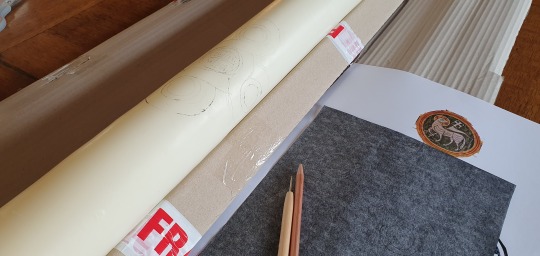

Design: Cosmati and the Cosmos
From the outset, I knew I wanted a candle with designs inspired by the artwork of the great Christian basilicas of Rome. I gave some consideration to a design inspired by the Lindisfarne Gospels, but thought this was too complex and ambitious. At another point, I thought of an icon of Christ emerging from the tomb and trampling the coronavirus underfoot! But I thought that it unwise for a beginner like me to try any figural work lest my depiction of the Lord become like the ‘Monkey Christ’ of Borja! So, I returned to the medieval designs that have long inspired me: Cosmatesque patterns.
Named after the Cosmati family, Cosmatesque patterns are sometimes called ‘opus alexandrinum’, perhaps because they originated in Alexandria. The geometric designs are certainly of Greek and Byzantine origins, and they’re first seen in the Western Church in the 11th century. According to Leo of Ostia, the abbot of Monte Cassino (the influential abbey founded St Benedict) “sent envoys to Constantinople to hire men who were experts in the art of laying mosaics and pavements”, and thus the transfer of knowledge about these Eastern patterns and designs came to the West. Cosmati work flourished in the 12th and 13th-centuries predominantly in Rome, but examples of Cosmatesque work are found throughout Italy, and even in Westminster Abbey in London. Its ‘Great Pavement’ was installed in 1268 on the sacred site where the monarch is crowned. Indeed, Cosmati work is costly, precious, and thus restricted to the most important of churches, often those associated with royalty or the papacy.
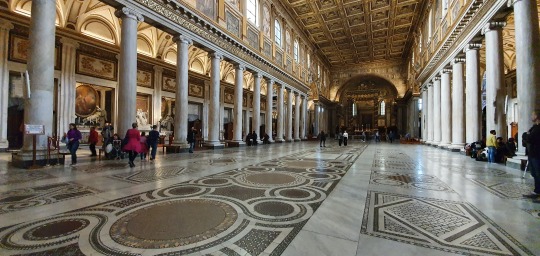

The stones used for laying the mosaic designs are almost always recycled from classical Roman sources, and two precious stones, coloured green and purple, feature in their design. Green porphyry was called Lapis Lacedaemonius by the Romans, and it came from quarries near Sparta in the Greek Peloponnese and was quarried from the Bronze Age until around the 5th century AD. The even rarer purple ‘Imperial Porphyry’, which was reserved to the Roman and Byzantine Emperors, comes from quarries at Mons Porphyrites in the Gebel Dokhan of Egypt’s Eastern Desert, quarried from the 1st century AD until the 5th century. Hence, by the time the Cormati family were active in Italy, green and purple porphyry were antiques that were no longer being quarried. The Cosmati pavements, therefore, accentuate and set off roundels of this legendary stone recycled from Roman spolia.
Cosmati designs generally have two geometric patterns: interlaced circular bands called guilloche, and which are said to represent the Resurrection, perhaps because they form a series of infinity loops; and secondly, the quincunx, which is a central circle surrounded by four circles. The quincunx is an ancient symbol, reminiscent of the Greek cross, which stands for the cosmos or an ordered universe. The Cosmatesque quincunx, moreover, with its triangular mosaics inlaid into the whirling circular pattern stands for the created world. As Galileo wrote: “The book of nature is written in the language of mathematics, and its letters are triangles, circles and other geometrical figures.” Hence, at Westminster Abbey, the Great Pavement uniquely had an inscription around the central quincunx design that referred to it as representing “the eternal pattern of the universe”.

At the centre of the Paschal candle, therefore, I placed a Cosmatesque quincunx, with triangles of green and purple around roundels of green and purple, evocative of imperial porphyry. I looked online for a design that could be easily traced, and printed this out, put the carbon paper on the candle, and then traced over this design with the embossing tool.
At first, I had intended to draw a cross in the central circle, and then, on the other four circles, I wanted to draw the ‘Alpha’ and ‘Omega’, and the year in Arabic numerals: ‘20′ - ‘20′. However, it was only after I had painted the quincunx that I recalled that the five incense grains would have to pierce these five circles, thus obscuring these symbols. So, an alternative solution had to be found! Incidentally, the five incense grains stand for the wounds of Christ, or the nails that pierced his body. I bought these golden pine-cones of wax from Italy, where they’re commonly used to pierce the Paschal candle – rather different from the brass pins we’re accustomed to in England, but they seem to work very well with this candle, and they add to the Romanitas of the design.

It was fitting, then, that this quincunx at the centre of the Paschal candle stand for the Cross of Christ, and for his Five Wounds – an observation made by James Joyce concerning the quincunx symbol. However, the quincunx is a rich symbol: as we’ve seen it also stands for the whole created order, which is now redeemed and transformed by the Risen Christ; or it stands for Christ in majesty surrounded by his four evangelists; or for the four Platonic elements of creation (fire, water, earth, and air) with the fifth element in the centre being aether, the Aristotelian quintessence. This design, therefore, signifies that all of creation is raised up and renewed by Christ rising from the dead; the whole cosmos is subjected to the imperial Christ, and resounds with the joy of his Gospel.
Our Lady’s Rosary and the Paschal Lamb

Having decided on the central cross-shaped quincunx, I knew I needed two more roundels that I wanted to add to lenghten the overall design. At the bottom would go the emblem of the Rosary Shrine, which is the monogram of the Blessed Virgin Mary surrounded by the Rosary.
I needed another emblem that would balance this at the top, and I chose the Lamb of God, a symbol of the Risen Lord. As St Paul says: “Christ, our Passover Lamb, has been sacrificed for us” (1 Cor 5:7), and this text is used in the Communion chant of Easter Sunday.
I searched for a medieval design of the Paschal lamb, and found this beautiful example on the ‘Cruz de Bagergue’ that dates from 1200. The Paschal lamb carries a flag featuring a red-cross on a white field, which is traditionally used as an emblem of the Resurrection, but it also conveniently looks like the flag of St George, i.e., the flag of England, which is the land now rededicated as Our Lady’s Dowry!
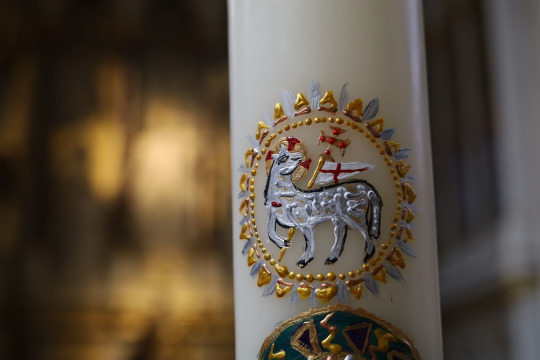
Alpha & Omega
However, what about the requisite signs on a Paschal candle? we needed a cross, and an Alpha, an Omega, and the numerals for this current calendar year. First, I painted a Greek cross in the central circle of the quincunx, using the alternating black and white Cross of the Dominican Order. But I fashioned it as a Greek cross, and around this I wrote the Greek letters IC XC NIKA. This emblem, called the Greek Christogram, has been in use since the 8th century, and it was found throughout Byzantium, notably on imperial coinage. It is a reference to the victory of Constantine at the Milvian Bridge in 312, and the Greek letters spell out: “Jesus Christ Conquers” i.e. through his Cross. By the 9th-century this emblem was believed to be apotropaic, that is to say, it is believed to have the power to drive away evil.
Continuing to be inspired by Byzantine art, I looked to examples of Crosses which had an Alpha and an Omega, the Greek letters for the Beginning and the End (cf Rev 22:13) hanging from them. The Altar Cross in Westminster Cathedral notably has these letters of the Greek alphabet hanging from its arms, and I researched and found medieval engravings and medallions with the same device. However, in all the old Byzantine images, the Omega was drawn not with the uppercase Ω but rather the lowercase ω. So, on the Paschal candle, I drew two jewelled Greek letters, the uppercase A and the lowercase ω suspended from the Cross-shaped quincunx. Following on from this, it seemed best to put the date above these, but rather than to write the date in Arabic numerals (2020), I opted to stay with the Roman-Byzantine theme, and so I chose the neat Roman numerals (MMXX), inscriped above the horizontal roundels of the quincunx.


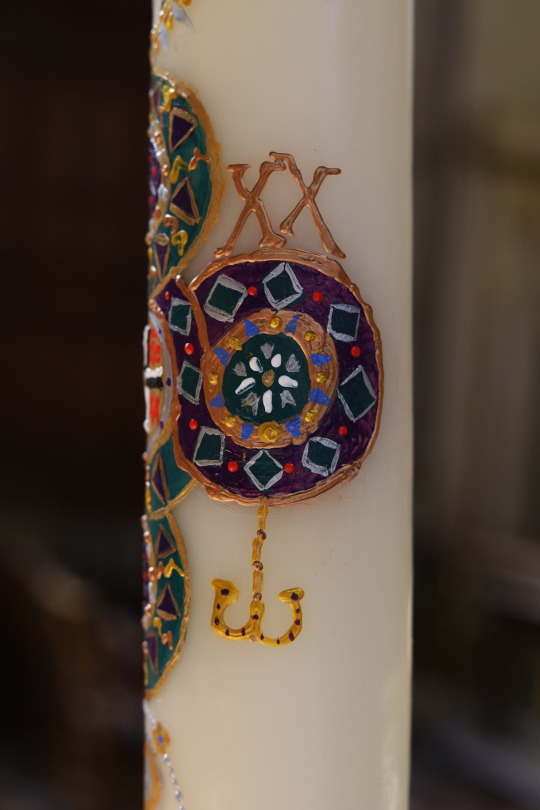
Flora and Beasts
Finally, I decided to add a few small elements to the candle so that not everything was centred around the middle portion of the candle. Near the top, I painted some bees, and then I added some to the bottom as well. Why bees? This is again a classical reference: Virgil, too, praised the industry and society of bees, and the Exsultet, which dates to at least the 4th century, says this concerning the Paschal candle:
“On this, your night of grace, O holy Father, accept this candle, a solemn offering, the work of bees and of your servants’ hands, an evening sacrifice of praise, this gift from your most holy Church. But now we know the praises of this pillar, which glowing fire ignites for God’s honour, a fire into many flames divided, yet never dimmed by sharing of its light, for it is fed by melting wax, drawn out by mother bees to build a torch so precious.”
Where there are bees, there ought to be flowers, so I added a few pink flowers, a reference to the cherry blossom (sakura 桜) which appear at this time, and which the Japanese enjoying viewing in the Spring (called hanami 花見), as a meditation on transience and impermanence, and the fleetingness of beauty. The exercise of painting the candle, I realised, is an exercise in detachment and impermanence because I would also come to sit in church, watching the candle burn down over the course of the year, and so consume and destroy that which I had painted. Sic transit gloria mundi!

Finally, I added a skep, the medieval bell-shaped hive made from coiled straw developed by apiculturists, and the hive is dripping with golden honey. It seemed fitting that the bees should have a place to live, and that their hive should be of the kind commonplace in Europe during the time that the Cosmati family engaged in their particular golden industry.
And then, as a little personal indulgence, I added a portrait of my beloved priory cat Felix. First consulting a book of ‘Cats in Medieval Manuscripts’, I adapted an illustration from the ‘Luttrell Psalter’, c.1325-35, and gave the cat the same colouring and pattern as Felix, who has a fine coat that looks like a Dominican habit. Felix has quite a penchant for sweet things – even though he’s not allowed them – and I am sure he’d love some honey, towards which he’s shown extending his paw.
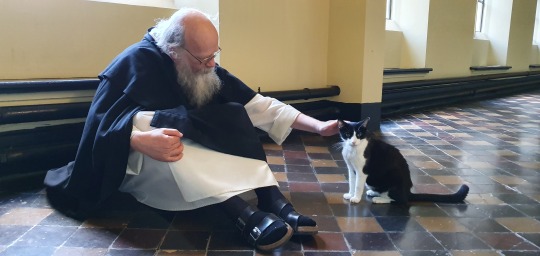
Technique
I wanted to avoid seeing brush stokes in the quincunx, so I learnt to dab my brush rather than just paint it in broad strokes. I realised that I didn’t need a lot of paint - often a pea-sized blob would suffice, with an equal sized blob of the acrylic binder: mix these well, and then, let it dry a little; the less wet the paint, the easier it was to paint on the wax. I learnt that, with acrylics, if one made a mistake, one could easily run over it with a wet brush, and the water washed away the paint like an eraser. As time went on, I rather enjoyed painting the candle, and it took me about 2 hours a day for 5 days, which is far quicker than I had expected.
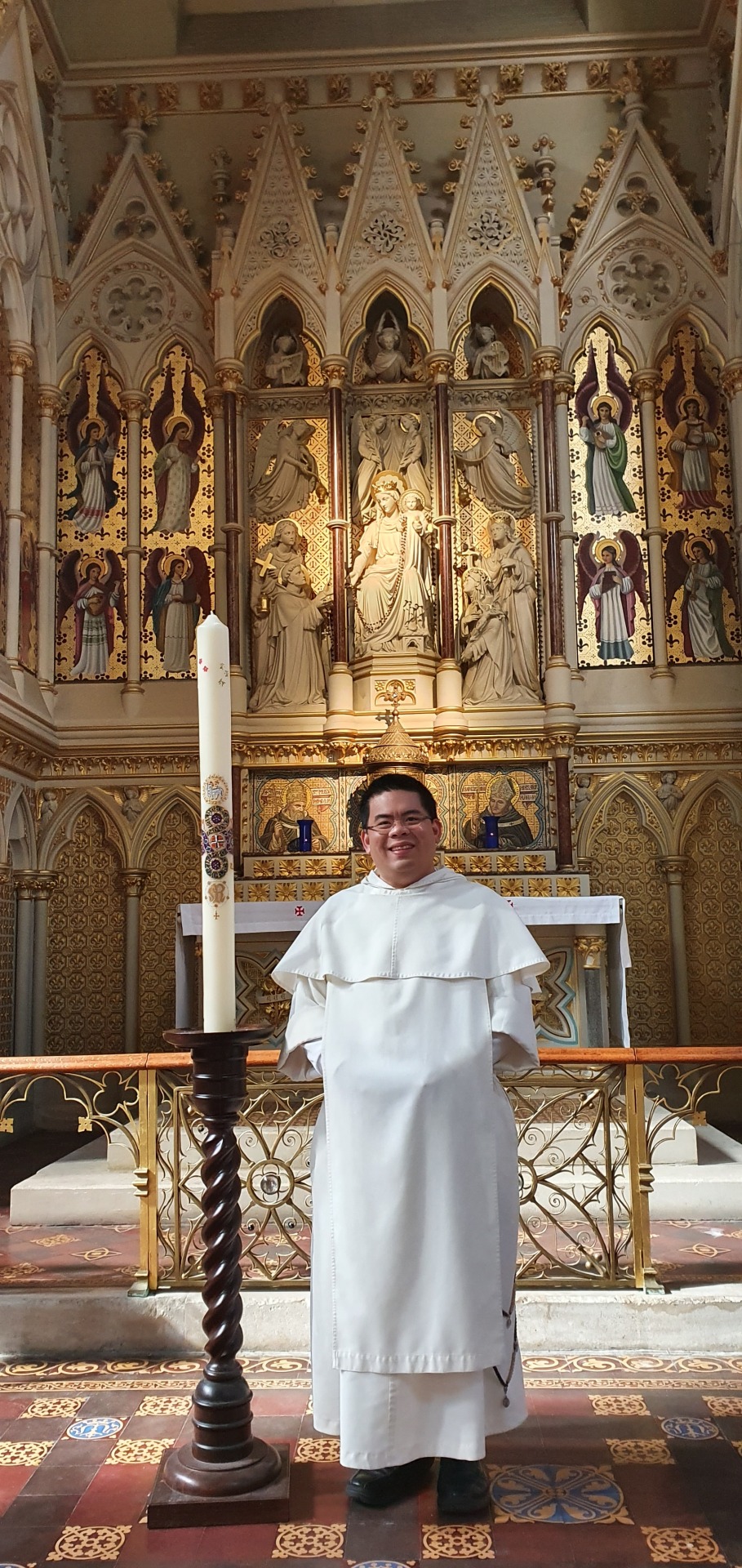
Final Reflections
As Providence would have it, I began work on the Paschal candle on the Monday of Passiontide. By that time, public Masses had ceased because of the coronavirus pandemic, and then, having more time on my hands, this project became a Godsend because it gave me something to focus on; it took my mind off the worries of the present moment. Painting the candle became an act of love, something beautiful and devotional that I could do for God and for the sacred Liturgy; it became a prayer, and indeed, I would pray as I painted the Rosary, or the Paschal Lamb. Finally, on Easter night, I pierced the quincunx with the wax pine-cones of encased incense, and then I saw it lit and raised high on the Paschal candle stand. And then, I was privileged to be the first to incense the candle, and then, to sing the Exsultet that praised God for it, asking that its
“flame be found still burning by the Morning Star: the one Morning Star who never sets, Christ your Son, who, coming back from death's domain, has shed his peaceful light on humanity, and lives and reigns for ever and ever.”
Amen.



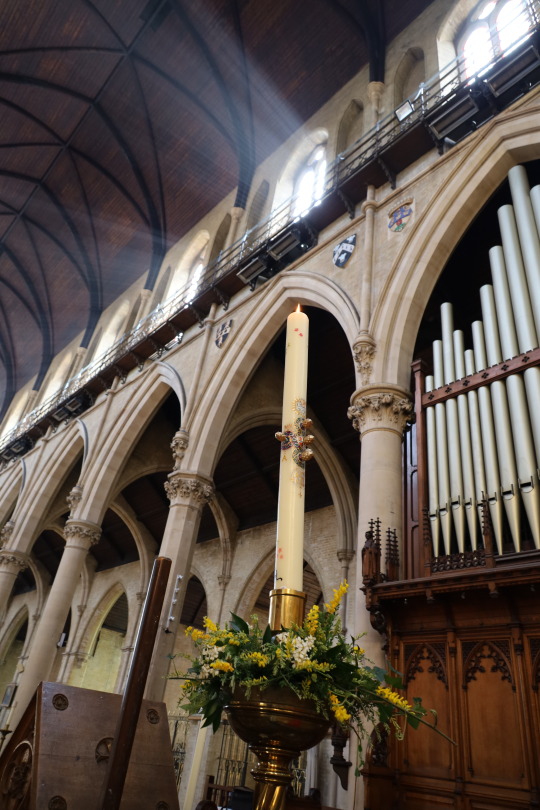
#Paschal Candle#Byzantine#Roman#Cosmati#Cosmatesque#imperial porphyry#Alpha#Omega#cat#bees#hive#acrylic#painting#crafts#FUN!#2020#Easter#Rosary Shrine#London#St Dominic's#Dominican
60 notes
·
View notes
Photo









like
8 notes
·
View notes
Photo

The legend, Juan Joya Borja has passed away. Here's his iconic video dubbed with Liverpool related subtitles. Enjoy via /r/LiverpoolFC https://ift.tt/3xAIffR
1 note
·
View note
Text
I got tagged by the wonderful @lilolilyr to list my top 5 male characters so here are my boys!

Comic book Clint Barton, with his incredibly relatable disaster bi energy

Harvey Quinn (yes that is an actual character) bc I love the gang of harleys comics and the silk booty shorts are iconic

Rhys Williams bc he’s a soft boy who deserves all the love and affection he’s so cute and excited to see gwen and tell her about his day at the depot literally every time it’s adorable but like also he’s lowkey a sexy badass lol

Borjas from the requirements of being a normal person bc who doesn’t love a sexy fat guy learning to love himself while also acting as a goofy supportive love interest for the protagonist


Doctor Ferriero from Pan’s Labarynth bc he’s a badass like I couldn’t not include the text for this it’s too iconic.
Tagging @stumpyfae @mushroomsandsunflowers @we-stan-six-the-musical @showstoppingnumbrr @mexicanfairy @aveasorae @clockwork--frog @mischief-pixie @lucyisanerd @artistmiabailey @wheatangels @pearlfaust
Hopefully I haven’t missed anyone?
#tag meme#i think thats what its called#hawkeye#clint barton#harvey quinn#gang of harleys#rhys williams#torchwood#the requirements of being a normal person#pan’s labyrinth#doctor ferriero
13 notes
·
View notes
Note
Mariaaaa 💖💖💖💖💖 what about Gareth and the babies of the squad? Marco, Borjita, Marcos, Theo, Jesus... (Love u a lot 😘)
AWWWW ❤️❤️❤️❤️❤️ I LOVE YOU TOO SWEETIE!! ❤️❤️❤️
First of all, can I just SAY! HOW! MUCH! I! LOVE! THE! BABIES! OF! OUR! SQUAD!!!!!!!!!!!! With such talented young players, our future is SOOOO bright!!!!!!!! ❤️❤️❤️
NOW, OMG, GARETH AND THE BABIES IS *SUCH* A CUTE COMBINATION, SO LETS TAKE A LOOK AT SOME ICONIC MOMENTS!!!
1. MARCO
OKAY SO WE ALL KNOW THAT GARETH AND MARCO IS A POWER DUO! AND THEY HAVE SOME PRETTY CUTE MOMENTS, LIKE THESEEEE:

OKAY HERE MARCO WAS AN *ACTUAL* BABY OSFNDFKDFNJDS

MARCO IS LIKE ”I WANNA TOUCH GAREEEEEEEETH”

ALSO, CAN WE TALK ABOUT *ALL* THESE RECENT MOMENTS THAT WE HAVE BEEN GETTING? MY EYES HAVE BEEN BLESSED









ALSO, THIS, FROM THE CHAMPIONS LEAGUE FINAL

2. BORJA
NOW, THIS IS MY FAVORITE GARETH x BABY BROMANCE. I HAVE TALKED ABOUT GARETH AND BORJITA SO MUCH, EVER SINCE THAT REAL SOCIEDAD MOMENT HAPPENED I COULD NOT STOP TALKING ABOUT THEM, LIKE:
ARE

YOU

KIDDING

ME

I SCREAMED WHEN I SAW THIS CELEBRATION

THEY ARE SO CUTE I CANT BREATHE


OK SO EXACTLY LIKE MARCO, BORJITA WAS AN *ACTUAL* BABY HERE

LOTS OF HUGSSSSSSSS





ALSO, THIS. I DONT HAVE WORDS FOR THIS, I WAS LITERALLY SPEECHLESS WHEN I SAW IT. REMEMBER WHEN BORJA PUT *THIS* ON HIS INSTAGRAM STORY??
LIKE?????
HE HAS????
THEIR CELEBRATION???
FRAMED!!!!!!!!!!

3. ODRI
OK SO THIS IS ALSO MY FAV GARETH x BABY BROMANCE. I HAVE ALWAYS HAD A SOFT SPOT FOR ALVARO, WHENEVER I SAW HIM WITH THE NT I WAS LIKE: ”LOOK AT ODRI! MY BABY BOY! I LOVE YOU SO MUCH!” . AND WHEN I HEARD HE IS COMING TO REAL, I LITERALLY HAD TEARS IN MY EYES. HE MEANS SO MUCH TO ME, AND THE FACT THAT HE IS SO CLOSE WITH MY FAV PLAYER OF ALL TIME, MY IDOL, GAZ, MEANS THE WORLD TO ME.
Now, there are only 2 moments-ish? That I know of. I mean, Alvaro has been in Madrid for only a month!! But I have seen training pics, how Alvaro likes every pic Gareth posts and stuff like that!
*LOOK* HOW GARETH LOOKS AT ODRI IM KJSAFKNFEN

AND OH MY GOD, *THIS*: This is a video, and i will link it HERE. BASICALLY ITS GARETH ENCOURAGING ODRI AND MAKING THE CUTEST GESTURES WHEN ODRI MAKES SOMETHING RIGHT JDSFNKEFEF ITS SO CUTE PLEASE WATCH IT!!
4. JESUS
OK THERE IS ONE MOMENT THAT HAS BEEN STUCK IN MY HEAD FOR A WHILE. REMEMBER THE CLUB WORLD CUP LAST YEAR? AND HOW JESUS WENT UP TO GET HIS MEDAL BUT HIS SITUATION WAS A LITTLE MORE COMPLICATED SO HE HAD TO EXPLAIN IT AND STUFF?? WELL GARETH MADE SURE HE WOULD GET THE MEDAL KEJSFNSLJEF THAT WAS LITERALLY THE CUTEST THING IN THE WORLD AND YOU CAN FIND THE VIDEO HERE.
AND I ALSO KNOW ABOUT THIS:

AND THISSSSS AFTER THE CHAMPIONS LEAGUE FINAL, GARETH WAS TALKING TO KARIUS AND JESUS CAME AND THEN THEY HUGGED:


5. DANI CEBALLOS
OK SO FOR THESE 2 I ONLY KNOW ABOUT THESE 2 MOMENTS:


Unfortunately I dont know and I couldnt find any Marcos x Gareth or Theo x Gareth moments 😭😭😭
BUT, FROM ALL OF THIS, WE CAN DEFINITELY SAY THAT GARETH LOVES OUR BABY SQUAD!!!!!!!!!!!!!!!! ❤️❤️❤️❤️❤️❤️❤️❤️❤️❤️❤️
#asks#Anonymous#gareth bale#marco asensio#borja mayoral#alvaro odriozola#jesus vallejo#dani ceballos#Real Madrid#ships best moments
26 notes
·
View notes